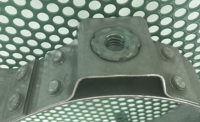Galvanized steel sheets have a zinc coating to prevent corrosion. The coating is effective as long as it’s not breached. Unfortunately, one of the most common methods of sheet metal assembly—resistance spot welding—does just that. Clinching, on the other hand, does not.
Clinching produces a round, button-like connection between two to four layers of sheet metal. The process can join metal sheets of different thicknesses. It can join dissimilar materials, such aluminum and copper, without creating an isolating intermetallic phase. The process can even be used on stainless steel.
Clinching will not damage anticorrosive coatings on the metal, and an adhesive or sealant can be located between the sheets. The minimum thickness for any one sheet in the assembly is 0.1 millimeter, and the entire stack can be up to 12 millimeters thick.
The process is primarily used in the manufacture of white goods, heating and ventilating components, and automotive parts.
The basis of each clinching system is the clinching tongs or clinching frame. The equipment includes an electromechanical servo drive or a hydropneumatic cylinder.

In clinching, a punch forces the layers of sheet metal into a die cavity. The pressure exerted by the press forces the punch-side metal to spread outwards within the die-side metal, creating a strong joint. Photo courtesy Tox Pressotechnik
The tools consist of a punch and a die that are designed specifically for the materials to be joined. There are two types of dies: solid, fixed-cavity dies, and dies with moving components. The punch forces the layers of sheet metal into the die cavity. The pressure exerted by the press forces the punch-side metal to spread outwards within the die-side metal. Joints can range from 1.5 to 26 millimeters in diameter.
The system can be complemented by force and displacement sensors for automatic control of the joining process and sequence parameters. Accessories include a spraying system for wetting the tools and materials, and a system to continuously check the condition of the die.
Ensuring a Successful Clinch
To get the most out of a joining process, the parts to be assembled should be designed with that process in mind.
If materials of different thickness will be joined, it’s best to have the thicker material on the punch side. The thicker material must be at the top so that enough material can flow into the die cavity. Otherwise, the neck area will be fragile. The thicker material should not be more than twice the thickness of the thinner material. The combined thickness of the two plies should not exceed the combined maximum thickness recommended for the die.
By the same token, if one material is considerably harder than the other, the harder material should be on the punch side. If the softer material is on the punch side, the punch will pass through the softer material, instead of deforming it.
The strength of a clinched joint depends on four factors: material type, material thickness, clinch point size and surface condition. Generally, a joint in steel is stronger than one in aluminum. Also, a dry surface will provide a stronger joint than if it is oiled or greased.

Tox TZ machine tongs (yellow) and a 50-kilonewton press (green) ensure reliable clinching of galvanized sheet metal. Photo courtesy Tox Pressotechnik
Clinching requires open flanges with good access to both sides for the punch and die tooling. The flange width must be sufficient to accommodate the interlocking button produced during clinching. The clearance between the center of the joint and the outer edge of the flange should be 1.5 times the punch diameter. Also, the clearance between the joint and the inner edge of the flange must be large enough to allow the tooling access to make the joint.
Clinch joints should be spaced to avoid previously formed joints, as well as the immediate area around them. Clinching in or near prior joints may result in unsatisfactory joint appearance, excessive thinning of the bottom sheet and accelerated tool wear. Also, joints should not be placed so close together that the material distorts. However, there must be enough joints to ensure that the assembled component meets strength requirements. A minimum joint spacing of two to three times the button diameter is recommended.
Accurate fit-up and alignment help form good joints by ensuring that the sheets are drawn together between punch and die in the correct manner. Joints should be fully closed after the clamping stage. Poor fit-up and alignment are major contributors to inconsistent clinch quality.
Clinching in Action
One company that is taking advantage of clinching is MiniTec GmbH & Co. in Schönenberg-Kübelberg, Germany.
MiniTec began in 1986 as a manufacturer of miniature linear guides for industrial machinery. Today, the company employs 420 people in 11 locations in Germany, France, Great Britain, Spain, Slovenia, China and the United States. Its offerings include conveyors, workstations, linear actuators, Cartesian motion systems, automated workcells, and even software for digital work instructions.
Recently, MiniTec helped an electronics assembler design and build a system to clinch galvanized sheet metal. MiniTec provided a custom XY positioning table, while press manufacturer and clinching specialist Tox Pressotechnik provided a powerful press, tongs and tooling. A unique feature of the system is that operators do not need to change tools. They select a product to assemble from an HMI, insert the parts, and start the process.

MiniTec began in 1986 as a manufacturer of miniature linear guides for industrial machinery. Today, the company employs 420 people around the world. Photo courtesy MiniTec GmbH & Co.
“To join galvanized sheets, we recommend clinching,” says Marco Unger, sales representative for Tox Pressotechnik in Weingarten, Germany. “The zinc layer can run with the joining process, after galvanizing. Spot welding is not required, and there is no area of corrosion.”
The electronics assembler wanted to optimize its processes, and it specified the assembly sequences in detail: The operator places the components on an XY table, moves away from the monitored danger zone, and presses the start button. A PLC then runs through the joining program. First. the table positions the parts at the desired position. A compensating slide then moves the tongs upwards, so the die is aligned below the sheet. Next, the punch is aligned from the top and joins the sheets. The tongs are then moved down, and the table is positioned for the next joint.
“Two experts developed a complete system from one source,” says Frank Stattaus, account manager at MiniTec.
For clinching, Tox supplied model TZ 05 machine tongs with compensation carriages and internal control. The TOX Powerpackage RZK provides the down-force. MiniTec acted as general contractor for the project, and developed an XY table with flexible base frame. A protective fence with a light curtain ensures safety. A controller monitors the various components and joints.
The complete system has paid off for the electronics assembler. Sheets can be clinched reliably and permanently, without creating any issues with corrosion later. Currently, 14 components of different sizes are joined on the system with a varying number of clinching points. The system can be programmed quickly and smoothly for new components.
For more information on sheet metal clinching, click here.
For more information on automation components, click here.
ASSEMBLY ONLINE
For more information on presses and sheet-metal assembly, read these articles:
Optimizing Work Cells for Press-fit Assembly
Common Mistakes With Presses
Clinching for Sheet Metal Assembly







